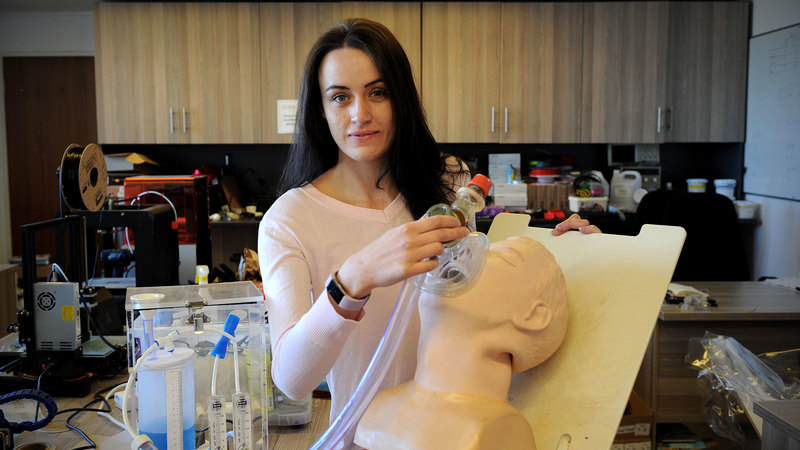Off-the-shelf tech solutions for Africa
14 August 2020 | Story Helen Swingler. Photo Lerato Maduna. Read time 6 min.In high school, Catherine Gordon-Grant was nicknamed Cathematics, such was her love for maths. But it’s in the applied field that the budding biomedical engineer, a master’s student at the University of Cape Town (UCT), finds meaning and purpose, especially when the solutions, usually medical devices, are inexpensive, locally applicable – and accessible.
Gordon-Grant is part of the Medical Devices Laboratory’s OpenAir Ventilation project, which started before lockdown kicked in – the lab’s members identified the need long before it became critical. The low-cost, continuous positive airway pressure solution uses off-the-shelf components, such as aquarium pumps, and leverages existing hospital infrastructure to give critically ill patients a continuous stream of pressurised air and high levels of oxygen through a mask. This keeps airways open and prevents lung collapse.
The shortage of ventilators for critical COVID-19 cases has been a challenge worldwide and was taken up by the country’s National Ventilator Project (NVP).
Sweet spot
Gordon-Grant, who studied actuarial science (“absolutely hating” it) before switching to mechanical engineering, was part of the testing team. In biomedical engineering, a master’s programme at UCT, she has found her niche: that gap between clinicians and engineers.
“Our initial system was far more complex, and I was focused on the electronic part of the system; the control and patient-monitoring system,” she explained. Working with their manufacturing partner, the CSIR, their first design was “toned down” to meet the NVP’s requirements.
She and her test partner, Edmund Wessels, designed a custom formative evaluation protocol for the CSIR’s device and conducted use-specific tasks with clinicians at Groote Schuur Hospital to identify any use errors and their root causes. This allowed the team to eradicate errors before distribution and roll-out of the device in a clinical setting.
The CSIR LIFE ventilator is in the last phase of production. Ten thousand units will be distributed to hospitals around the country to assist in what is likely to be a long wait until a reliable vaccine has been found, procured and rolled out.
Work smart and cheap
At the heart of the Medical Devices Laboratory’s work is Frugal Biodesign, a game changer in the field of medical-device design in Africa. This can be a tongue depressor or, in Gordon-Grant’s pre-COVID-19 work, a non-invasive proprioceptive feedback system (a device that provides users with information about the position, motion and sensation of a prosthetic limb) for transradial (below the elbow) amputees.
“Low-cost, accessible solutions are always important for developing countries like South Africa because we import over 90% of our medical devices.”
COVID-19 put a huge burden on the country, she said.
“Low-cost, accessible solutions are always important for developing countries like South Africa because we import over 90% of our medical devices. Low-cost solutions can save our healthcare system an enormous amount of money and improve accessibility for people in rural areas.”
With an eye on doing good, Gordon-Grant said: “It was an incredible experience and a real privilege for me to be involved in this project.”
And though the prospect of a continuous learning loop excites her, the course is about much more than developing medical devices.
“It takes you through an extensive process of medical-device design considering not only the design and clinical aspect, but the commercialisation, economic, regulatory and legal aspects too.”
Design work, hands on
The tomboy who grew up tagging two older brothers is reflective about the role of women in engineering. On the face of it, the numbers appear to be healthy.
“But when you break it [engineering] up into individual fields – electronic, chemical, mechanical, industrial – that’s when the numbers can be surprising.”
As a mechanical engineering undergraduate at Stellenbosch University in 2018, Gordon-Grant was one of the women who made up only 10% of the class.
“It was a running joke during undergrad projects – and there were a lot – that the boys did the heavy lifting and design work and the women wrote the reports.”
“It was a running joke during undergrad projects – and there were a lot – that the boys did the heavy lifting and design work and the women wrote the reports at the end. This makes it incredibly difficult for the women who actually enjoy the design work and getting their hands dirty.”
Blatant sexism at any level of education must stop, she said.
“The subtle (and not-so-subtle) sexism throughout a woman’s life – from childhood to adulthood – and the stigma associated with a woman having a successful career, keep women away from careers in engineering and science.
“The good news is that women are starting to fight back against sexist gender roles and stigmas in everyday life. Hopefully this means that more young girls will be inspired to choose careers in engineering.”
She added: “It’s important to acknowledge that there are still many mountains to climb … it’s important not to be satisfied with the status quo and to remember that you have the ability to make an indelible impact.”
 This work is licensed under a Creative Commons Attribution-NoDerivatives 4.0 International License.
This work is licensed under a Creative Commons Attribution-NoDerivatives 4.0 International License.
Please view the republishing articles page for more information.
Research & innovation






































